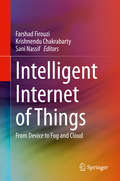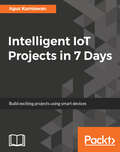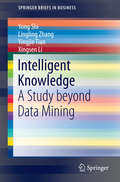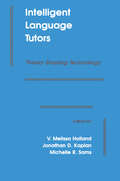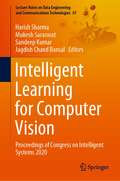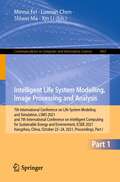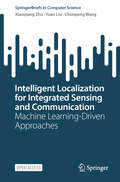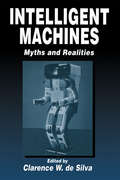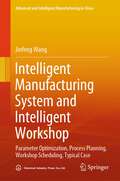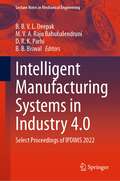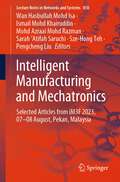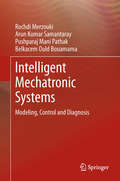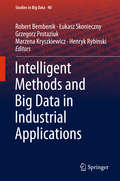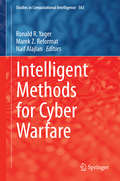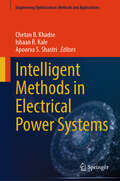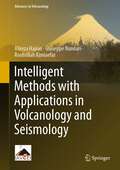- Table View
- List View
Intelligent Internet of Things for Smart Healthcare Systems (Advances in Smart Healthcare Technologies)
by Neha Sharma Deepak Sinwar Durgesh Srivastava Jabar H. Yousif Hari Prabhat GuptaThe book focuses on developments in artificial intelligence (AI) and internet of things (IoT) integration for smart healthcare, with an emphasis on current methodologies and frameworks for the design, growth, implementation, and creative use of such convergence technologies to provide insight into smart healthcare service demands. Concepts like signal recognition, computation, internet of health stuff, and so forth and their applications are covered. Development in connectivity and intelligent networks allowing for social adoption of ambient intelligence is also included. Features:•Introduces Intelligent IoT as applicable to the key areas of smart healthcare.•Discusses computational intelligence and IoT-based optimizations of smart healthcare systems•Explores effective management of healthcare systems using dedicated IoT-based infrastructures•Includes dedicated chapters on securing patient’s confidential data •Reviews diagnosis of critical diseases from medical imaging using advanced deep learning-based approaches This book is aimed at researchers, professionals, and graduate students in intelligent systems, big data, cloud computing, information security, and healthcare systems.
Intelligent Internet of Things: From Device to Fog and Cloud
by Krishnendu Chakrabarty Farshad Firouzi Sani NassifThis holistic book is an invaluable reference for addressing various practical challenges in architecting and engineering Intelligent IoT and eHealth solutions for industry practitioners, academic and researchers, as well as for engineers involved in product development. The first part provides a comprehensive guide to fundamentals, applications, challenges, technical and economic benefits, and promises of the Internet of Things using examples of real-world applications. It also addresses all important aspects of designing and engineering cutting-edge IoT solutions using a cross-layer approach from device to fog, and cloud covering standards, protocols, design principles, reference architectures, as well as all the underlying technologies, pillars, and components such as embedded systems, network, cloud computing, data storage, data processing, big data analytics, machine learning, distributed ledger technologies, and security. In addition, it discusses the effects of Intelligent IoT, which are reflected in new business models and digital transformation. The second part provides an insightful guide to the design and deployment of IoT solutions for smart healthcare as one of the most important applications of IoT. Therefore, the second part targets smart healthcare-wearable sensors, body area sensors, advanced pervasive healthcare systems, and big data analytics that are aimed at providing connected health interventions to individuals for healthier lifestyles.
Intelligent Interpretation for Geological Disasters: From Space-Air-Ground Integration Perspective
by Lizhe Wang Cheng Zhong Weitao Chen Xuwen QinThis book comprehensively utilizes the new generation of artificial intelligence and remote sensing science and technology to systematically carry out researches on high-precision recognition, monitoring, analysis, and assessment of geological disasters by using different technologies of "ground, airspace, and space-based systems" and different scales of "target-semantic-region". The main contents include: 1) Intelligent interpretation theory and methods of geological disasters, 2) Intelligent analysis of landslide based on long-term ground monitoring data, 3) Intelligent analysis of landslide evolution based on optical satellite remote sensing data, 4) Deep learning-based remote sensing detection of landslide, 5) Intelligent assessment methods of landslide susceptibility, 6) Intelligent recognition of ground figure based on airspace-based remote sensing data. The book is of interest to graduate student, scientific, and technological personnel who work in the area of geological disasters, natural hazards, remote sensing, and artificial intelligence.
Intelligent IoT Projects in 7 Days
by Agus KurniawanDiscover how to build your own Intelligent Internet of Things projects and bring a new degree of interconnectivity to your world. About This Book • Build intelligent and unusual IoT projects in just 7 days, • Create home automation, smart home, and robotic projects and allow your devices to do smart work • Build IoT skills through enticing projects and leverage revolutionary computing hardware through the RPi and Arduino. Who This Book Is For If you're a developer, IoT enthusiast, or just someone curious about Internet of Things, then this book is for you. A basic understanding of electronic hardware, networking, and basic programming skills would do wonders. What You Will Learn • Learn how to get started with intelligent IoT projects • Explore various pattern recognition and machine learning algorithms to make IoT projects smarter. • Make decisions on which devices to use based on the kind of project to build. • Create a simple machine learning application and implement decision system concepts • Build a smart parking system using Arduino and Raspberry Pi • Learn how to work with Amazon Echo and to build your own smart speaker machine • Build multi-robot cooperation using swarm intelligence. In Detail Intelligent IoT Projects in 7 days is about creating smart IoT projects in just 7 days. This book will help you to overcome the challenge of analyzing data from physical devices. This book aims to help you put together some of the most exciting IoT projects in a short span of time. You'll be able to use these in achieving or automating everyday tasks—one project per day. We will start with a simple smart gardening system and move on to a smart parking system, and then we will make our own vending machine, a smart digital advertising dashboard, a smart speaker machine, an autonomous fire fighter robot, and finally look at a multi-robot cooperation using swarm intelligence Style and approach A clear step-by-step instruction guide to completing fully-fledged projects in just 7 days
Intelligent IoT Projects in 7 Days: Build exciting projects using smart devices
by Agus KurniawanDiscover how to build your own Intelligent Internet of Things projects and bring a new degree of interconnectivity to your worldKey FeaturesBuild intelligent and unusual IoT projects in just 7 daysCreate home automation, smart home, and robotic projects and allow your devices to do smart workBuild IoT skills through enticing projects and leverage revolutionary computing hardware through the RPi and ArduinoBook DescriptionIntelligent IoT Projects in 7 days is about creating smart IoT projects in just 7 days. This book will help you to overcome the challenge of analyzing data from physical devices. This book aims to help you put together some of the most exciting IoT projects in a short span of time. You'll be able to use these in achieving or automating everyday tasks—one project per day. We will start with a simple smart gardening system and move on to a smart parking system, and then we will make our own vending machine, a smart digital advertising dashboard, a smart speaker machine, an autonomous fire fighter robot, and finally look at a multi-robot cooperation using swarm intelligence.What you will learnLearn how to get started with intelligent IoT projectsExplore various pattern recognition and machine learning algorithms to make IoT projects smarterMake decisions on which devices to use based on the kind of project to buildCreate a simple machine learning application and implement decision system conceptsBuild a smart parking system using Arduino and Raspberry PiLearn how to work with Amazon Echo and to build your own smart speaker machineBuild multi-robot cooperation using swarm intelligenceWho this book is forIf you're a developer, IoT enthusiast, or just someone curious about Internet of Things, then this book is for you. A basic understanding of electronic hardware, networking, and basic programming skills would do wonders.
Intelligent Knowledge
by Yong Shi Yingjie Tian Lingling Zhang Xingsen LiThis book is mainly about an innovative and fundamental method called "intelligent knowledge" to bridge the gap between data mining and knowledge management, two important fields recognized by the information technology (IT) community and business analytics (BA) community respectively. The book includes definitions of the "first-order" analytic process, "second-order" analytic process and intelligent knowledge, which have not formally been addressed by either data mining or knowledge management. Based on these concepts, which are especially important in connection with the current Big Data movement, the book describes a framework of domain-driven intelligent knowledge discovery. To illustrate its technical advantages for large-scale data, the book employs established approaches, such as Multiple Criteria Programming, Support Vector Machine and Decision Tree to identify intelligent knowledge incorporated with human knowledge. The book further shows its applicability by means of real-life data analyses in the contexts of internet business and traditional Chinese medicines.
Intelligent Language Tutors: Theory Shaping Technology
by V. Melissa Holland Jonathan D. Kaplan Michelle R. SamsThe techniques of natural language processing (NLP) have been widely applied in machine translation and automated message understanding, but have only recently been utilized in second language teaching. This book offers both an argument for and a critical examination of this new application, with an examination of how systems may be designed to exploit the power of NLP, accomodate its limitations, and minimize its risks. This volume marks the first collection of work in the U.S. and Canada that incorporates advanced human language technologies into language tutoring systems, covering languages as diverse as Arabic, Spanish, Japanese, and English. The book is organized into sections that express the levels of analysis dealt with in learning and teaching a language and with the tasks of the student as writer, reader, conversant, and actor in the world. These sections bring together research by specialists in linguistics, artificial intelligence, psychology, instructional design, and language teaching. In addition to providing detailed descriptions of working systems, amply illustrated with screens from lesson and authoring interfaces, the contributors address a spectrum of common issues: * What can current NLP technology contribute to computer-assisted language instruction and to research on language learning? * How can this technology meet the demands of pedagogical theory for communicative language teaching in authentic contexts? * How can designers constrain tutoring environments to ensure accurate analysis of learners' language? * What can NLP-based systems teach us about language acquisition, about linguistic theory, and about theories of language pedagogy? * What lessons have been learned in using these systems to date? Discipline-specific issues are illuminated as well: the relative merits of the major syntactic frameworks for NLP-based language tutoring; the adaptation of theories like lexical conceptual structure to support semantic interpretation; the integration of input language with visual microworlds and dialogue games; the pragmatics of the tutoring discourse; the selection of instructional principles to guide system design; and the accomodation of design to individual differences and learner styles. A concluding section assesses this work from larger theoretical and practical perspectives -- experimental psychology and psycholinguistics, linguistics, language teaching, and second language acquisition research.
Intelligent Learning for Computer Vision: Proceedings of Congress on Intelligent Systems 2020 (Lecture Notes on Data Engineering and Communications Technologies #61)
by Sandeep Kumar Jagdish Chand Bansal Harish Sharma Mukesh SaraswatThis book is a collection of selected papers presented at the First Congress on Intelligent Systems (CIS 2020), held in New Delhi, India, during September 5–6, 2020. It includes novel and innovative work from experts, practitioners, scientists, and decision-makers from academia and industry. It covers selected papers in the area of computer vision. This book covers new tools and technologies in some of the important areas of medical science like histopathological image analysis, cancer taxonomy, use of deep learning architecture in dental care, and many more. Furthermore, this book reviews and discusses the use of intelligent learning-based algorithms for increasing the productivity in agricultural domain.
Intelligent Life System Modelling, Image Processing and Analysis: 7th International Conference on Life System Modeling and Simulation, LSMS 2021 and 7th International Conference on Intelligent Computing for Sustainable Energy and Environment, ICSEE 2021, Hangzhou, China, October 30 – November 1, 2021, Proceedings, Part I (Communications in Computer and Information Science #1467)
by Xin Li Minrui Fei Shiwei Ma Luonan ChenThis three-volume set CCIS 1467, CCIS 1468, and CCIS 1469 constitutes the thoroughly refereed proceedings of the 7th International Conference on Life System Modeling and Simulation, LSMS 2021, and of the 7th International Conference on Intelligent Computing for Sustainable Energy and Environment, ICSEE 2021, held in Hangzhou, China, in October 2021. The 159 revised papers presented were carefully reviewed and selected from over 430 submissions.The papers of this volume are organized in topical sections on: Medical Imaging and Analysis Using Intelligence Computing; Biomedical signal processing, imaging, visualization and surgical robotics; Computational method in taxonomy study and neural dynamics; Intelligent medical apparatus, clinical applications and intelligent design of biochips; Power and Energy Systems; Computational Intelligence in Utilization of Clean and Renewable Energy Resources, and Intelligent Modelling, Control and Supervision for Energy Saving and Pollution Reduction; Intelligent Methods in Developing Electric Vehicles, Engines and Equipment; Intelligent Control Methods in Energy Infrastructure Development and Distributed Power Generation Systems; Intelligent Modeling, Simulation and Control of Power Electronics and Power Networks; Intelligent Techniques for Sustainable Energy and Green Built Environment, Water Treatment and Waste Management; Intelligent Robot and Simulation; Intelligent Data Processing, Analysis and Control in Complex Systems; Advanced Neural Network Theory and Algorithms; Advanced Computational Methods and Applications; Fuzzy, Neural, and Fuzzy-neuro Hybrids; Intelligent Modelling, Monitoring, and Control of Complex Nonlinear Systems; Intelligent manufacturing, autonomous systems, intelligent robotic systems; Computational Intelligence and Applications.
Intelligent Localization for Integrated Sensing and Communication: Machine Learning-Driven Approaches (SpringerBriefs in Computer Science)
by Yuan Liu Xiaoqiang Zhu Chunpeng WangIntegrated Sensing and Communication (ISAC) systems. As 6G networks advance, the need for more efficient data collection, more intelligent system adaptability, and more accurate localization results. Traditional outdoor localization methods like GPS are limited indoors due to signal blockages, underscoring the need for innovative indoor localization technologies to meet the evolving requirements of modern applications. This "Open Access" book addresses key challenges in indoor localization using Channel State Information (CSI) and machine learning. It covers three core aspects: 1. More Efficient CSI Collection: Reducing human intervention in the data collection process through automated methods while ensuring high-quality, reliable data. 2. More Intelligent CSI Updates: Developing adaptive mechanisms that allow for real-time updates of CSI values, ensuring system robustness and flexibility in dynamic environments. 3. More Accurate Localization Applications: Employing advanced machine learning algorithms to improve localization precision, even in complex indoor settings. Through comprehensive theoretical insights and real-world experimental studies, this book presents the latest advancements in CSI-based indoor localization systems. The various machine learning techniques explored demonstrate their robustness and adaptability in real-world settings. Ideal for researchers, engineers, and students, this "Open Access" book provides both foundational and cutting-edge knowledge for anyone interested in developing intelligent indoor localization systems. Whether you&’re new to the field or an experienced professional, this "Open Access" book offers valuable insights for advancing localization technologies in the age of ISAC and 6G.
Intelligent Machines: Myths and Realities
by Clarence W, de SilvaWhat is intelligence? Are truly intelligent machines a practical reality? If so, can they work in harmony with human beings and improve the quality of our lives? How are they designed, built, and controlled? The fact is that machines with brains are no longer the stuff of science fiction. Research focused on developing smarter, more flexible
Intelligent Manufacturing System and Intelligent Workshop: Parameter Optimization, Process Planning, Workshop Scheduling, Typical Case (Advanced and Intelligent Manufacturing in China)
by Jinfeng WangThis book focuses on the basic common technologies of smart manufacturing system and smart workshop. The applications of artificial intelligence in manufacturing system have been addressed from different perspectives, for example, smart optimization of cutting parameters, smart process planning, smart workshop and scheduling, and smart integration of process planning and scheduling. In the process of writing, this book highlights the combination of basic theory and engineering practice. In the basic theory part, the book clearly explains the basic issues of smart manufacturing system, including the core support technology of smart manufacturing, the basic theories and models of cutting parameter optimization, process optimization and scheduling, and the basic concepts and intelligence of smart manufacturing workshop model, optimization methods, etc. In the engineering practice part, this book enumerates a large number of research cases, trying to clearly demonstrate the basic problems of manufacturing system intelligence, and each chapter is accompanied by typical cases to help readers better understand and master the basic theories involved in stamping.
Intelligent Manufacturing Systems in Industry 4.0: Select Proceedings of IPDIMS 2022 (Lecture Notes in Mechanical Engineering)
by B. B. Biswal B. B. V. L. Deepak D. R. K. Parhi M. V. A. Raju BahubalendruniThis book presents the select proceedings of the 4th International Conference on Innovative Product Design and Intelligent Manufacturing System (IPDIMS 2022). It covers the latest trends in the areas of design and manufacturing. The main topics covered include Industry 4.0, smart manufacturing, advanced robotics, and CAD/CAM/CIM. The contents of this book are useful for researchers and professionals working in the disciplines of mechatronics, mechanical, manufacturing, production, and industrial engineering.
Intelligent Manufacturing and Energy Sustainability: Proceedings of ICIMES 2019 (Smart Innovation, Systems and Technologies #169)
by Margarita N. Favorskaya Suresh Chandra Satapathy A. N. R. Reddy Deepak Marla Milan SimicThis book includes selected, high-quality papers presented at the International Conference on Intelligent Manufacturing and Energy Sustainability (ICIMES 2019) held at the Department of Mechanical Engineering, Malla Reddy College of Engineering & Technology (MRCET), Maisammaguda, Hyderabad, India, from 21 to 22 June 2019. It covers topics in the areas of automation, manufacturing technology and energy sustainability.
Intelligent Manufacturing and Energy Sustainability: Proceedings of ICIMES 2020 (Smart Innovation, Systems and Technologies #213)
by Margarita N. Favorskaya Suresh Chandra Satapathy A. N. R. Reddy Deepak MarlaThis book includes best selected, high-quality research papers presented at the International Conference on Intelligent Manufacturing and Energy Sustainability (ICIMES 2020) held at the Department of Mechanical Engineering, Malla Reddy College of Engineering & Technology (MRCET), Maisammaguda, Hyderabad, India, during August 21-22, 2020. It covers topics in the areas of automation, manufacturing technology and energy sustainability and also includes original works in the intelligent systems, manufacturing, mechanical, electrical, aeronautical, materials, automobile, bioenergy and energy sustainability.
Intelligent Manufacturing and Energy Sustainability: Proceedings of ICIMES 2021 (Smart Innovation, Systems and Technologies #265)
by Margarita N. Favorskaya Suresh Chandra Satapathy A. N. R. Reddy Deepak MarlaThis book includes best selected, high-quality research papers presented at the International Conference on Intelligent Manufacturing and Energy Sustainability (ICIMES 2021) held at the Department of Mechanical Engineering, Malla Reddy College of Engineering & Technology (MRCET), Maisammaguda, Hyderabad, India, during June 18-19, 2021. It covers topics in the areas of automation, manufacturing technology and energy sustainability and also includes original works in the intelligent systems, manufacturing, mechanical, electrical, aeronautical, materials, automobile, bioenergy and energy sustainability.
Intelligent Manufacturing and Energy Sustainability: Proceedings of ICIMES 2022 (Smart Innovation, Systems and Technologies #334)
by Deepak Marla Amaranadha Reddy Manchuri V. Vasudeva RaoThis book includes best selected, high-quality research papers presented at the International Conference on Intelligent Manufacturing and Energy Sustainability (ICIMES 2022) held at the Department of Mechanical Engineering, Malla Reddy College of Engineering & Technology (MRCET), Maisammaguda, Hyderabad, India, during June 24–25, 2022. It covers topics in the areas of automation, manufacturing technology, and energy sustainability and also includes original works in the intelligent systems, manufacturing, mechanical, electrical, aeronautical, materials, automobile, bioenergy, and energy sustainability.
Intelligent Manufacturing and Energy Sustainability: Proceedings of ICIMES 2023 (Smart Innovation, Systems and Technologies #372)
by Vishesh Ranjan Kar P. H. V. Sesha Talpa Sai Srikar Potnuru Mehmet AvcarThis book includes best selected, high-quality research papers presented at the International Conference on Intelligent Manufacturing and Energy Sustainability (ICIMES 2023) held at the Department of Mechanical Engineering, Malla Reddy College of Engineering & Technology (MRCET), Hyderabad, India, during June 23–24, 2023. It covers topics in the areas of automation, manufacturing technology, and energy sustainability and also includes original works in the intelligent systems, manufacturing, mechanical, electrical, aeronautical, materials, automobile, bioenergy, and energy sustainability.
Intelligent Manufacturing and Energy Sustainability: Proceedings of ICIMES 2024 (Smart Innovation, Systems and Technologies #114)
by Ajit Behera Srikar Potnuru HyukSu Han P.H.V. Sesha Talpa SaiThis book includes best selected, high-quality research papers presented at the International Conference on Intelligent Manufacturing and Energy Sustainability (ICIMES 2024) held at the Department of Mechanical Engineering, Malla Reddy College of Engineering & Technology (MRCET), Hyderabad, India, during June 21–22, 2024. It covers topics in the areas of automation, manufacturing technology, and energy sustainability and also includes original works in the intelligent systems, manufacturing, mechanical, electrical, aeronautical, materials, automobile, bioenergy, and energy sustainability.
Intelligent Manufacturing and Mechatronics: Selected Articles from iM3F 2023, 07–08 August, Pekan, Malaysia (Lecture Notes in Networks and Systems #850)
by Mohd Azraai Mohd Razman Ismail Mohd Khairuddin Pengcheng Liu Wan Hasbullah Mohd Isa Sarah 'Atifah Saruchi Sze-Hong TehThis book presents parts of the iM3F 2023 proceedings from the mechatronics as well as the intelligent manufacturing tracks. It highlights recent trends and key challenges in mechatronics as well as the advent of intelligent manufacturing engineering and technology that are non-trivial in embracing Industry 4.0 as well as addressing the UN Sustainable Development Goals. The book deliberates on conventional as well as advanced solutions that are utilized in the variety of mechatronics and intelligent manufacturing-based applications. The readers are envisaged to gain an insightful view on the current trends, issues, mitigating factors as well as solutions from this book. It provides a platform that allows academics as well as other relevant stakeholders to share, discuss, and deliberate their latest research findings in the field of manufacturing, mechatronics, and materials, respectively.
Intelligent Mechatronic Systems
by Rochdi Merzouki Pushparaj Mani Pathak Arun Kumar Samantaray Belkacem Ould BouamamaActing as a support resource for practitioners and professionals looking to advance their understanding of complex mechatronic systems, Intelligent Mechatronic Systems explains their design and recent developments from first principles to practical applications. Detailed descriptions of the mathematical models of complex mechatronic systems, developed from fundamental physical relationships, are built on to develop innovative solutions with particular emphasis on physical model-based control strategies. Following a concurrent engineering approach, supported by industrial case studies, and drawing on the practical experience of the authors, Intelligent Mechatronic Systems covers range of topic and includes: An explanation of a common graphical tool for integrated design and its uses from modeling and simulation to the control synthesis Introductions to key concepts such as different means of achieving fault tolerance, robust overwhelming control and force and impedance control Dedicated chapters for advanced topics such as multibody dynamics and micro-electromechanical systems, vehicle mechatronic systems, robot kinematics and dynamics, space robotics and intelligent transportation systems Detailed discussion of cooperative environments and reconfigurable systems Intelligent Mechatronic Systems provides control, electrical and mechanical engineers and researchers in industrial automation with a means to design practical, functional and safe intelligent systems.
Intelligent Methods and Big Data in Industrial Applications (Studies in Big Data #40)
by Marzena Kryszkiewicz Robert Bembenik Łukasz Skonieczny Henryk Rybinski Grzegorz ProtaziukThe inspiration for this book came from the Industrial Session of the ISMIS 2017 Conference in Warsaw. It covers numerous applications of intelligent technologies in various branches of the industry. Intelligent computational methods and big data foster innovation and enable the industry to overcome technological limitations and explore the new frontiers. Therefore it is necessary for scientists and practitioners to cooperate and inspire each other, and use the latest research findings to create new designs and products. As such, the contributions cover solutions to the problems experienced by practitioners in the areas of artificial intelligence, complex systems, data mining, medical applications and bioinformatics, as well as multimedia- and text processing. Further, the book shows new directions for cooperation between science and industry and facilitates efficient transfer of knowledge in the area of intelligent information systems.
Intelligent Methods for Cyber Warfare
by Ronald R. Yager Marek Z. Reformat Naif AlajlanCyberwarfare has become an important concern for governmental agencies as well businesses of various types. This timely volume, with contributions from some of the internationally recognized, leaders in the field, gives readers a glimpse of the new and emerging ways that Computational Intelligence and Machine Learning methods can be applied to address problems related to cyberwarfare. The book includes a number of chapters that can be conceptually divided into three topics: chapters describing different data analysis methodologies with their applications to cyberwarfare, chapters presenting a number of intrusion detection approaches, and chapters dedicated to analysis of possible cyber attacks and their impact. The book provides the readers with a variety of methods and techniques, based on computational intelligence, which can be applied to the broad domain of cyberwarfare.
Intelligent Methods in Electrical Power Systems (Engineering Optimization: Methods and Applications)
by Ishaan R. Kale Apoorva S. Shastri Chetan B. KhadseThis book provides a comprehensive review of the latest developments in optimization based learning algorithms within the field of electrical engineering. It covers various power system applications including efficient power system operation, load forecasting, fault analysis, home automation and efficient smart grid management. Each application is accompanied by case studies and a literature review in self-contained chapters. The book is dedicated to study the effectiveness of intelligent methods in addressing the power system problems and its mitigation using optimization algorithms. It discusses several optimization algorithms such as random forest algorithm, metaheuristic algorithm, scaled conjugate gradient descent algorithm, artificial bee colony algorithm etc. and their usability in intelligent decision makers for the various optimization problems in electrical engineering. This timely book serves as a practical guide and reference sources for students, researchers and professionals.
Intelligent Methods with Applications in Volcanology and Seismology (Advances in Volcanology)
by Giuseppe Nunnari Alireza Hajian Roohollah KimiaefarThis book presents intelligent methods like neural, neuro-fuzzy, machine learning, deep learning and metaheuristic methods and their applications in both volcanology and seismology. The complex system of volcanoes and also earthquakes is a big challenge to identify their behavior using available models, which motivates scientists to apply non-model based methods. As there are lots of seismology and volcanology data sets, i.e., the local and global networks, one solution is using intelligent methods in which data-based algorithms are used.

